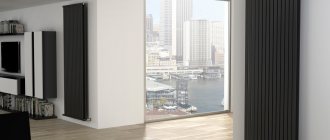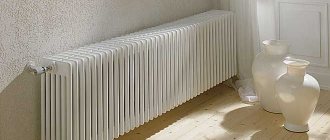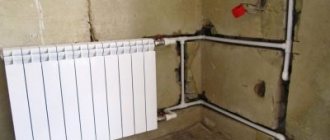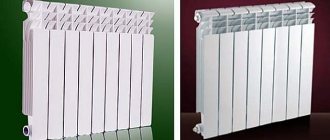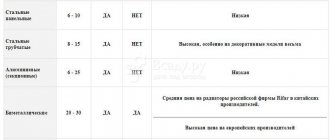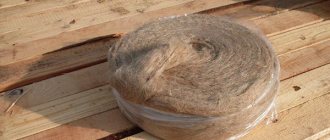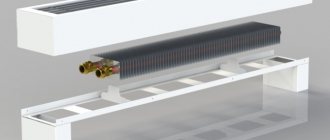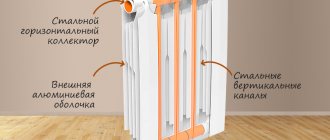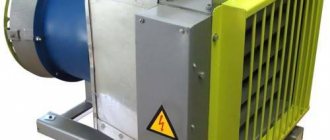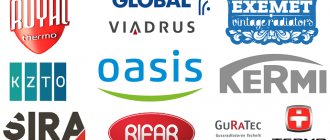Low heating radiators are found in any group of heating devices. This category includes equipment whose height does not exceed 45 cm. Such small batteries are usually sought for aesthetic reasons: with panoramic glazing or low window sills. Sometimes you need to heat an entire cold wall, in which case this is one of the most effective options. After all, low radiators have low heat transfer, which means their length will be significant, which is what is needed to heat a cold or “wet” wall.
It is clear that you want everything to look stylish, but in heating you cannot focus only on aesthetics: technical data are also very important. That’s why they pay attention to the metal from which they are made. After all, it is its properties that largely determine the characteristics of radiators and their scope of application.
Aluminum
The lowest aluminum radiators have a height of 245 mm. The Sira campaign has such models: Alux 80 and Alux 100, Rovall 80 and Rovall 100, Swing. They have a good heat output for such miniature products - 89-97 W. Global has a low radiator - model Gl-200/80/D. This model is cast, with a working pressure of 16 bar.
The lowest radiator at Global Gl-200/80/D has a height of 200 mm
There are aluminum radiators with a center distance of 200 mm from the Russian manufacturer – Rifar [/anchor] – these are Rifar Base 200 and Rifar Forza 200. Moreover, their back wall is solid. You can safely place them with your back to the window and not worry about the appearance from the street.
But these are the smallest radiators. There is a large selection of models, the height of which will not be higher than 45 cm. Every company has such sizes, in almost every line. A center distance of 300 mm, 350 mm or 400 mm also fits into the low category.
Advantages, disadvantages
In any line there are low batteries, with an interaxial distance of 300 or 350 mm.
Advantages of aluminum radiators: lightweight, have high heat transfer, small capacity (little water can be placed), quickly respond to temperature changes.
The most important disadvantage is the chemical reactivity of aluminum and its softness. For normal and long-term operation, a high-quality coolant is required: Ph 7-8, operating pressure - from 5-6 Bar for extrusion models, to 10-12 for cast ones. It is imperative that the coolant contains a small amount of oxygen and suspended matter. Oxygen promotes the oxidation and destruction of aluminum, and suspensions wear down the metal.
But each manufacturer has its own requirements. For example, Chinese aluminum Radena radiators operate at 16 Bar pressure and coolant with Ph 6.5-9. And Sira extrusion models have a working pressure of 16 Bar and a warranty period of 25 years. There are probably other aluminum radiators whose characteristics go far beyond the average: and there are too many manufacturers and models.
When choosing, do not forget about all these technical subtleties: only if the operating conditions coincide with the manufacturers’ recommendations, the heating will work for a long time and without failures.
When installing the system, it is worth remembering that aluminum cannot be combined with copper (or copper-based alloys) directly. This means that when installing copper pipes, it is better to install other radiators. And also do not install bronze or brass fittings. Galvanized fittings and fittings work well with aluminum.
Application area
Scope of application: in individual heating there are practically no restrictions, it is only worth paying attention to the temperature of the coolant, especially if the system has a coal or wood boiler. It is risky to install them in apartments. Unless they are very reliable and proven, and only if the coolant in the system meets the manufacturer’s requirements.
Read about the choice of radiators for an apartment and a house in the article “Aluminum batteries: types, selection, connection”
Advantages and disadvantages of floor-standing models
Floor radiators are connected to a common heating system and installed on legs.
A floor radiator unit can be installed on special legs or built into the floor surface, mounted like a plinth. Compared to standard options, they have several advantages:
- compactness – small-sized products do not clutter up the space;
- high heat transfer coefficient of models made of cast iron, bimetal, aluminum;
- laconic appearance - suitable for any interior design;
- several color options - standard batteries are made in white, but manufacturers paint them according to the RAL catalog, playing with different textures;
- ease of installation - installation work is reduced to connecting to the heating system or screwing into the floor;
- efficient heating of a room where there is a large window;
- Possibility of installation next to walls.
The disadvantages of floor heating radiators include the need to organize floor wiring and the difficulty of finding the right model in offline stores. Disadvantages also include low price compared to classic options and heating using convection technology.
The floor-standing device can be combined with a classic battery near the wall or under the windowsill.
Bimetallic
Bimetallic radiators are usually called heating devices in which the collectors through which water flows are made of steel (sometimes stainless, sometimes black). An aluminum “jacket” of ribs is then fused onto this frame (to increase heat transfer).
Bimetallic radiators do not have very small radiators
Such batteries have a high operating pressure - up to 20-24 Bar, can work with almost any coolant (stainless steel manifolds work with any), and have a fairly high heat transfer. Their disadvantage: often a small cross-section of vertical ducts, as well as a high price.
The situation here is almost the same as in aluminum ones: some manufacturers have very small radiators with a height of 245-265 mm (the same Sira and Rifar have them), and almost all of them have a height from 350 mm to 450 mm.
Advantages, disadvantages
Advantages - high working pressure, compatibility with any metals (aluminum does not come into contact with the coolant or supply pipelines). Works with coolant in a wide range - Ph 6.5-9 in models with steel collectors and Ph from 5 to 10-11 in models with stainless steel (Royal Thermo, Calidor, Nova Florida, Radena). Another good quality is the high heat transfer of the section, as well as low inertia (allows you to accurately regulate the temperature in the room using an automatic boiler or a temperature regulator for the radiator).
Disadvantages: high price, which is due to the high complexity of the technology. And one more drawback: some companies make vertical collectors of small diameter, and if there is a high content of suspended particles in the coolant, they can become clogged. Therefore, it is advisable to install filters at the inlet (and they need to be cleaned regularly).
Application area
This type of radiator was developed specifically for the conditions of our central heating. That’s why they need to be installed in high-rise apartments. They will work great in individual heating, but why pay a lot of money for an unnecessary safety margin (almost tenfold)?
Options inserted into the floor
Floor-mounted built-in heating radiators provide even greater secrecy of the heating installation. They are installed directly in floor niches, and heat is removed through a metal or wooden grid mounted level with the floor level.
- These devices can be mounted in doorways and not obstruct passages.
- The selected radiator is connected to a centralized heating system using tubes.
- The described structures are available in aluminum, copper and steel types.
- Floor-mounted heating radiators are known for their versatility, which cannot be said about wall-mounted options.
- They can be installed in every building - residential, office or commercial.
This type of radiator is suitable for private homes with French windows. Such heaters are used for heating galleries, shops and greenhouses. Radiators placed inside floors are used with great success for rooms with a special microclimate.
Cast iron
Long gone are the days when cast iron batteries were of only one type. The “Soviet” accordion is far from the only option; there are also modern, palace, and art nouveau styles. There are wall and floor models. Wall-mounted ones are basically the same “accordion” - MS-140, etc., as well as ordinary sectional ones, the style familiar today. Floor-standing ones are more often referred to as design radiators. And, unfortunately, they cost a lot. But they look stylish. Read about the types and types of radiators, their manufacturers and technical characteristics here.
Cast iron radiators are now available in a modern style
“Accordion” is also being produced today, and it is in good demand. Called MS-140, MS-110 and MS-90. There are also low models: with an interaxal distance of 300 mm, and a mounting height of 382-388 mm (the height varies slightly among different manufacturers).
Cast iron radiators are available in a modern style: they look very similar to aluminum and bimetallic ones. In this group, the smallest radiators will also be slightly less than 400 mm.
Retro style cast iron radiators are often small
And the third group of cast iron batteries is design radiators. They are mostly floor-mounted - on legs. And their sizes are also about the same: around 40 cm (with legs). But some companies have very compact ones:
- model BOLTON 220 with installation height 330 mm;
- The Hellas 270 from Viadrus has a height of only 340 mm.
There may be other low cast iron radiators: there are so many different offers, it’s impossible to track everything.
Advantages, disadvantages
The undoubted advantages are a long service life, low price (except for design radiators) and the ability to work with any coolant. Disadvantages - large mass and fragility, difficult to process, cannot be repaired, low operating pressure - 9-10 bar.
There are also properties that in one case are an advantage, and in another - a disadvantage:
- Great inertia. Thick walls take a long time to heat up when the system is overclocked. But they also take a long time to cool down. This feature allows them to smooth out temperature fluctuations when using a conventional coal boiler.
- Large cross-section of sections. A lot of water is placed in them, which again leads to increased inertia of the system and the use of a more powerful pump in systems with forced circulation. But for systems with natural circulation, the low hydraulic resistance of wide collectors is a definite plus.
Application area
All these properties determine the scope of use of cast iron radiators, including low ones: they are optimally suited for individual heating systems (houses, dachas, cottages). They work well in small high-rise buildings: where the operating pressure in the system does not exceed 9-10 bar. They make no other demands on the coolant: they don’t care whether there is oxygen, how many suspended particles are contained, or what its acidity is. With periodic washing they will last a long time.
Read how to clean the battery here.
What else to look for when choosing
Before you buy low and narrow batteries, you should pay attention to some nuances in choosing products. The efficiency of the heating system will depend on this. To spend your money wisely, it is recommended to consider the following conditions:
- It is better to heat rooms equipped with panoramic windows using aluminum or bimetallic batteries;
- It is better to heat your own houses with an autonomous heating system with radiators made of steel or aluminum;
- the length of the radiator under the window must exceed the width of the window. This will create an effective thermal curtain over the entire window area;
- it is necessary to clarify the operating pressure in the system;
- determine the battery connection side.
Steel tubular
This category has the largest range of low radiators. And the low ones here are:
- from 150 mm height for Purmo - Delta Laserline model;
- from 180 mm, Arbonia has almost all models of the “standard” range, there is also a radiator-bench, with a height of 180 mm;
- from 190 mm for Zehnder, Charleston model and bench radiators from 400 mm and 410 mm.
- With an axle distance of 300 mm from the Russian KZTO.
Tubular radiators are very decorative
At any manufacturer of tubular radiators you will find those that can be classified as low. They can have from two to six columns of pipes, respectively, they will have different depths - from 50 mm to 250 mm. Each of the models can be installed on the floor or hung on the wall (specify when ordering).
Advantages and disadvantages
Tubular radiators can have a nonlinear shape.
The advantages include a large selection of models, with different widths and depths, ease of cleaning, attractive appearance, and a large number of decorative options. The large cross-section of the pipes creates little hydraulic resistance, and such radiators rarely become clogged.
Disadvantages are caused by steel: susceptibility to corrosion, high requirements for coolant, low operating pressure, short service life - from 5 to 10 years. Exception: Zehnder Charleston Pro
, which is internally treated with two compounds. They resist corrosion so well that this option can stand at Ph 5-11. The warranty period is 25 years.
Application area
Basically, tubular radiators are designed for individual heating. Moreover, they can work both in systems with forced and natural gravity. The only requirement is that the system must be closed.
Dimensions of high narrow and low convectors
Standard heating radiators have the following parameters: length - 93 mm, depth 140 mm, height 388 mm. Such structures have good heat transfer if they are made of thin alloys. If this is a cast iron option, the power of one section will be 106 watts.
Designs that are used for heating small spaces (tall radiators) have the following dimensions: width 76 mm, height 661-954 mm, depth 203 mm. The operating pressure of such a heater is 10 atmospheres.
Steel panel
Steel panel radiators are low: they are usually made from 300 mm in height (here it is the height of the radiator, and not the interaxal distance). Any manufacturer has them: Russian Prado and European Purmo and Kermi.
There are also lower ones, but they are rare. So ]Purmo[/anchor] has models Ventil Compact, Purmo Planora and Ramo Compact. Their height starts from 200 mm (center distance 150 mm). We haven't found any others this small.
Steel panel radiators can be very low
Advantages and disadvantages
The advantages of steel radiators include their compact size and the lowest price per kilowatt of power. In addition, steel is a non-capricious metal that does not conflict with other components of the system.
The main disadvantage is the tendency to corrosion, and hence the demand for coolant: Ph 7-8 and lack of oxygen (closed systems). The panel walls have a thickness of 1.25 mm or 1.4 mm. If the coolant is of poor quality, they can be corroded within a few seasons. There is another disadvantage, which is due to the design: the small width of the channels through which the coolant circulates. If there is a large amount of contaminants in the coolant, they quickly become clogged. But flushing such a radiator is a problem. Another disadvantage is the difficulty of cleaning in the presence of plates with convective ribs.
Read more about steel radiators here.
Application area
Normally, panel radiators are installed in individual closed systems (with a closed expansion tank). Coolant circulation must be forced: these heating devices have high hydraulic resistance.
It is not recommended to install them in high-rise apartments; the pressure rarely allows this (working 10 bar). Only in systems that have their own water treatment (independent type of connection) with a mandatory deaeration stage (air removal).
Copper-aluminum radiators
This type of radiators and convectors, with their small sizes, is characterized by high heat transfer. This is usually a copper pipe on which aluminum plates are attached. This device is hidden in a painted steel casing (sometimes found in stainless steel). Most of the manufacturers on the market produce low copper-aluminum radiators:
- “Thermia” - height from 200 mm, bottom and side connections.
- Regulus-sistem - all models with a height of 215 mm;
- "IzoTerm" - from 215 mm;
- Mars - sectional type with a height of 385 mm.
Read about manufacturers and models of copper-aluminum and copper radiators here.
The photo shows copper-aluminum radiators Regulus-sistem
Advantages, disadvantages
The advantage of this type of low radiators is a fairly large heat transfer with small sizes (a 200mm * 400mm radiator produces 240 W). The second good property is that copper does not require a closed system, and Ph should be in the range of 7-9. Quite a high working pressure - 16 Bar.
But, despite such characteristics, it is not recommended to install it in systems with centralized heating: if the copper itself reacts little to the quality of the coolant, then it corrodes the solder and leaks appear at the soldering points. And, in addition, copper is incompatible with some metals, and also reacts poorly to a high content of abrasive particles, which simply erase it (copper is soft and gradually wears off, and this is one of its main disadvantages). Another drawback is the high price, as well as creaks and rustling noises that occur when radiators cool and heat up (but this is only for domestic models, European manufacturers have learned to deal with this, ours have not yet).
Inside copper-aluminum radiators there is this or a similar design
Application area
Again, these radiators will work well in individual systems (with forced circulation). But the wiring is preferably made of copper, polymer or metal-polymer pipes. In apartments, low copper-aluminum radiators will work normally provided that the coolant and operating pressure requirements are met. It is also necessary to install a filter at the inlet.
Battery thickness
The dimensions of bimetallic heating radiators, therefore, may be different. Their depth is usually 80 or 100 mm. Sometimes 90 mm options are also available for sale. In this case, the choice depends solely on the personal preferences of the home owners themselves. If the niche for the battery is deep, you can purchase a thicker radiator. If the wall is in the same plane as the edge of the window sill, you should, of course, buy an 80 mm radiator. In this case, if necessary, it will be easier to disguise it.
Baseboard heating
This type of heating devices appeared in our country not so long ago. These are devices very similar to copper-aluminum radiators: the same copper tube on which copper or aluminum convective plates are placed. They just have a different connection method, layout and different dimensions. Heating elements can be inserted into heating modules (tubes with plates) or they can be assembled into closed circuits through which the coolant circulates. They are located along the floor along the perimeter of the walls, covered with metal decorative overlays. The width is about 3 cm, the height is 12-20 cm, depending on the power. Exactly low radiators.
This is what baseboard heating looks like. No more other heating devices
Advantages, disadvantages
The advantage is that most of the heat (70-80%) is transferred by thermal radiation. The heat rising from warm baseboards heats up the walls first. They then begin to radiate heat. Therefore, a more uniform temperature is observed in the room, and warm air does not accumulate at the top.
Another plus is its very compact size and quite high heat output: one meter produces 180-280 W at average temperatures. In addition, they are not conspicuous and provide wide scope for design solutions.
The only downside is the high price.
Application area
Excellent in individual heating systems. It is possible to install electric heated skirting boards in apartments. Connecting to central heating requires a complex system: for optimal operation, the difference between the supply and return pipelines should not exceed 5oC, therefore each circuit should be no more than 12-14 meters long, and a mixing unit must be installed to maintain normal temperature.
Connection features
For connection, a side or bottom connection is used.
Regardless of the design, floor heaters are connected to the system according to the principle of standard modifications with a bottom type of connection:
- The heat exchanger pipe is located in the legs or supports, so there is no need to mask it.
- The height of the brackets is adjusted and they are leveled with the building level.
- Auxiliary brackets are screwed to the floor surface.
- The radiator is fixed to the legs or body.
- A temperature control knob is placed on the side.
At the last stage, the quality of the connections is checked and the strapping is performed.
Floor-standing radiator models do not take up much space, so they are combined with panoramic glazing. When choosing a device, you need to focus on the material of manufacture, the number of sections and thermal efficiency.
